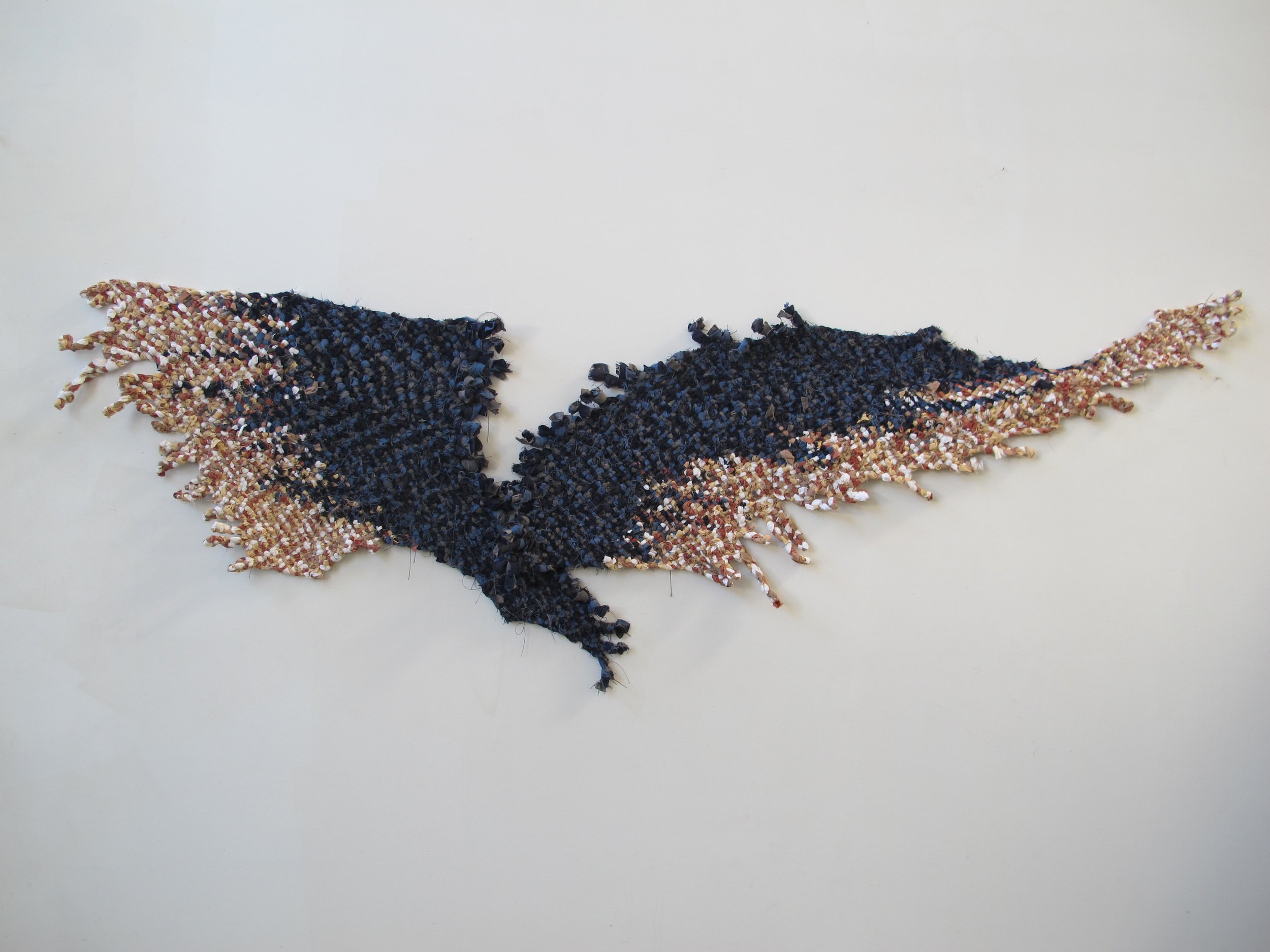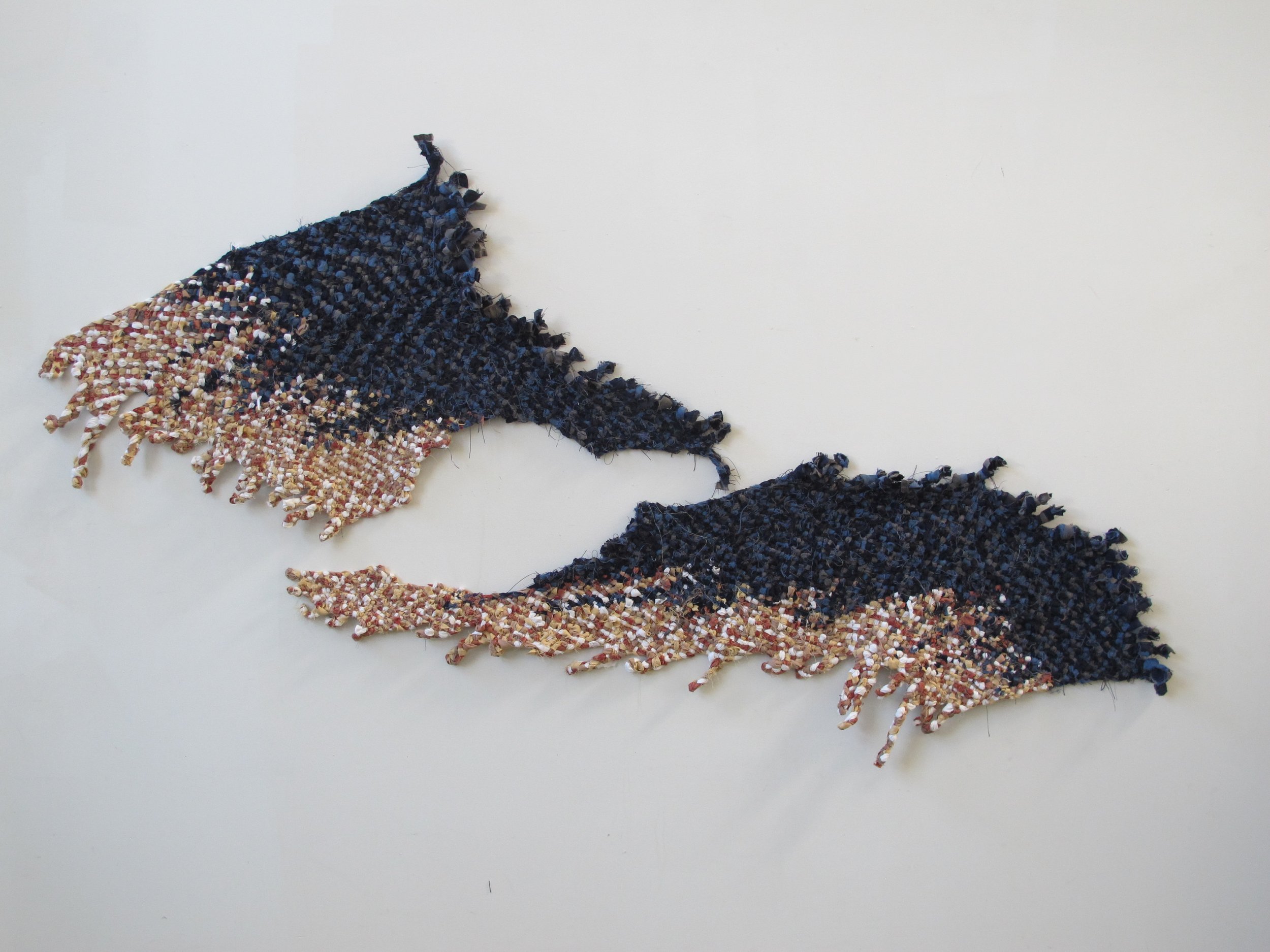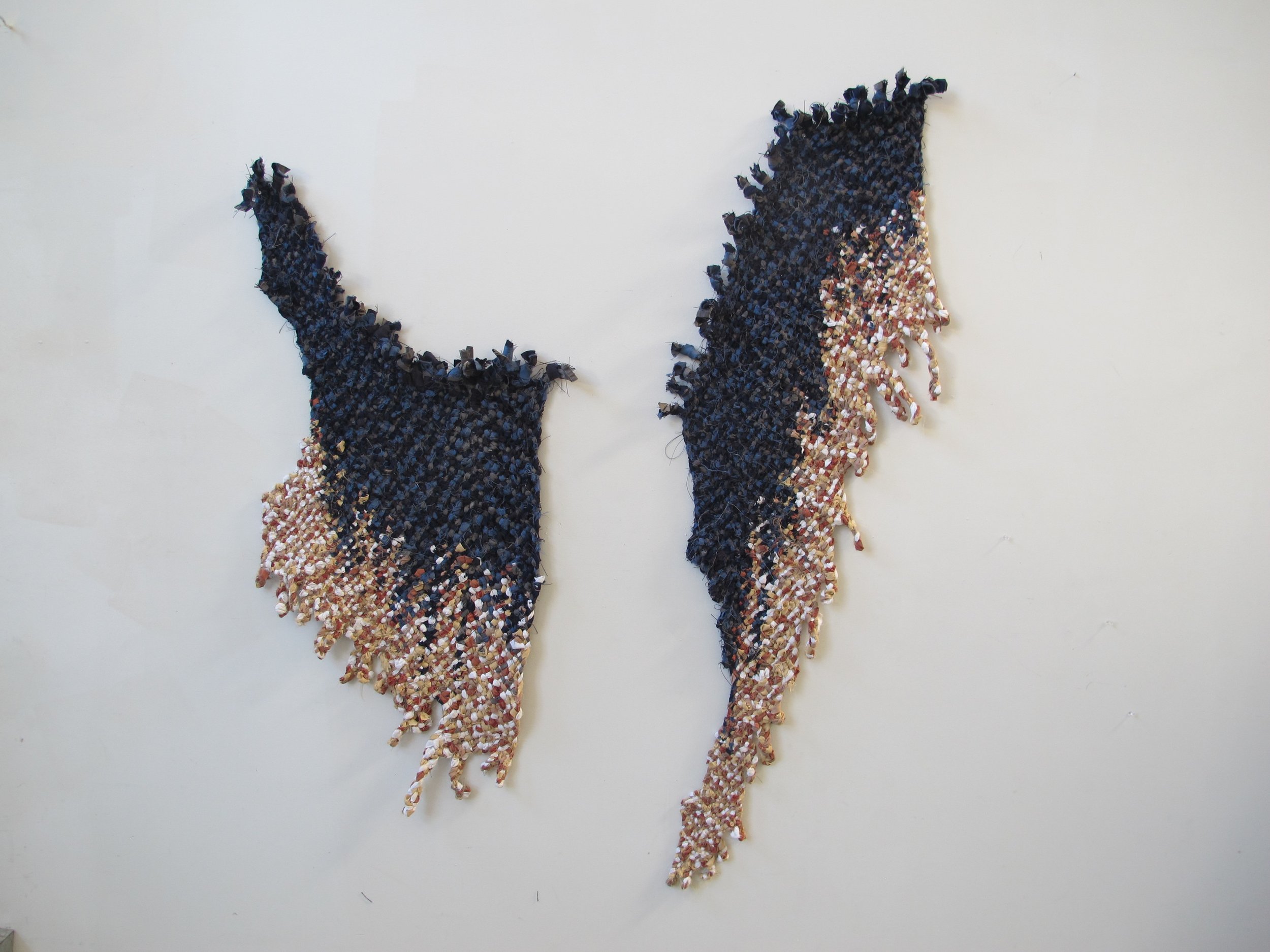Scanning For Pulp
Cord Gibson
“They’re death workers, full stop.”
Interview by L. Valena
Can you start by describing what you responded to?
Yeah! I responded to a piece of visual art that was sent to me. I’m not certain of the exact medium. I certainly feel very curious about the process and the person behind that art, but I allowed myself to let go of that and trust that I’ll learn about it later... because it’s freaking gorgeous. I love it. As soon as I opened it, I felt very struck, not only because it felt connected to themes and colors that I’ve been holding, but also because it’s objectively gorgeous.
Aside from recognizing the gorgeousness of it, what were your other first reactions to it?
I was immediately struck by the element of air, and my response piece ended up being about turkey vultures. The piece had tons of bird imagery. Wings, sky, egg, shadow. There were so many pieces that jumped out at me. So it was pretty quick, I looked at it and pretty quickly and knew what the piece was going to be. That was really fun.
So talk to me about turkey vultures.
I think they’re agents of death. I think they’re beautiful. I have a friend who is particularly obsessed with them, and it’s her birthday today, so I’m thinking about her a lot. The way they fly overhead, and you can just follow their shadows on the land, in a really different way from most other birds. I feel like I can see the shadow of the turkey vulture more than I can with other birds -- that might not be true, it might just be a feeling that I have. I think when I hike, I’m often getting up to the same level as the vultures, and that they’re looking for their next decomposing opportunity. They’re deep with metaphor, death, decomposition. I think the way their wings end, and the feathers come out like hands- there are a lot of gaps between the feathers. It’s like a big triangular wing, but to me, turkey vultures have fingers that are trawling out through the skies. Gorgeous. Stunning.
I’ve been making braided scrap rugs lately. That’s been the main energy of my practice, and that’s what this was. I made a pair of rugs that were I guess meant to be wings. This process was a new experience for me. Usually, I’m not very planned out with rugs. I’ll choose colors, but I won’t have a vision in my brain to begin with. This was the first time I planned out the number of rows the rug would have, at what point it was going to do its different transitions between colors. It feels difficult to explain -- I haven’t put words on it before. But I was trying to be very planned out, I had a vision. There was going to be this cutout circle in the center that was going to kind of mimic the floating egg in the piece that you sent me. And it was really a nice challenge to try to visualize something and go with it. And then, of course, the piece I submitted was fully not what I planned out. It felt like a nice balance between planning and letting the wings reveal themselves.
It’s so hard to hold both at once, right? To have a plan, but also to know when to let the plan go, and allow the thing to become what it’s meant to be. I commend you for walking through that.
It is hard. Also, I don’t know what’s good art. I don’t know how to make my art good, I don’t know what is aesthetically pleasing to other people. So why not just leave some things up to chance, and see what comes out of that.
Can you tell me more about your process?
Some rugs I make are circles, and just get woven in a circle. There’s a way to braid as you go, and you braid into the existing rug. That means instead of making a long braid and stitching it to itself, you can just braid it right onto itself and there are no stitches. This one is slightly different. Each rug is 25 rows. You start with one long braid, and once that’s the length you want it to be, you make another which you are then braiding on the right side. There’s no stitching. When I first started making rugs and just guessing how to do it, I was making long braids that I stitched onto themselves. But I don’t like that as much. Then I started following artists online and seeing the way that you don’t need stitches. It’s been a process.
How do you usually present your rugs? Do you normally hang them on the wall like this?
I feel torn about that. Rugs are meant to be on the floor, I’ve heard. But most of the pieces I make end up on walls. Some are on the floor — I’m looking around my room, and there are some on the floor, that I use. I’m here for the metaphors, I think there’s something beautiful about rugs connecting us to the earth. Every morning and night, I have a practice of standing on one of the first rugs I made to ground and arrive in this earthly pain/physical body. So it is helpful to be on the ground when I’m trying to stand on them. But some of them just seem like they want to be on the wall, and also my room doesn’t have any more floor space. This one has yet to go on the ground — it’s a wall piece for now.
It’s in the air, right?
Exactly. Thank you. I’m saved by that.
You sent this work in essentially three different arrangements. Do you see them as having a particular arrangement? Or does if feel more modular to you?
I don’t know! I was trying to document it and send it to you on the night it was due. And I just started moving it around, it was kind of Tetris piece-y. Seeing some of the different edges lined up in different ways. I do like that it came out as having three different configurations, and maybe there are more. I don’t feel wed to any one. I find each of them appealing in different ways. I think maybe having it modular mimics some wing-flapping energy. The many different shapes that a bird takes overhead.
Do you think the artwork is the rugs themselves, or the photos of the rugs?
At this moment, I am just not a photographer. If you had been there the night I was trying to photograph these and saw the way I brought my bedside lamp out and tried to position it and have like a photoshoot... I had to borrow my roommate’s phone because my phone takes shit photos. I make rugs. I don’t take pictures. Sometimes I have to take pictures when I’m submitting them to things, but I think the art is the rug.
One thing I still haven’t decided is whether these two rugs are definitely going to end up together. I could see them splitting and kind of being sister pieces in separate places.
You mentioned that you associate turkey vultures with grief and death. Do you want to talk about your relationship with death, or grief, or any of these big-ticket subjects?
Recently, whenever I have a weird interaction with a friend, or in some odd mood, the first question I’ve been asking myself is, “Am I grieving something? What am I grieving?” I can’t speak for other people or other communities. I have not experienced the depth of loss associated with Covid, or ongoing climate collapse, white supremacy, the violence of our imperial government. Specifically in the sharpness of its anti-Blackness, the way that tar sands are now running through Line 3, the way a new president comes in and a bunch of people with proud blue eyelids decide to close them right up again. I inhabit a body and experienced an upbringing that has immunized me from a lot of those things, and at the same time, I still think there’s grief coursing through this life. I don’t think that is disconnected from this work. I know that I do textiles broadly because I’m trying to be okay in this world. I know that I need to be okay in this world because it gives us so many reasons to grieve. I think grief is natural, and even in a natural system where all beings are treated well, there would still be grief. So I don’t think grief is synonymous with white supremacy/capitalism/violence/patriarchy, but I do think those systems are creating so many unnecessary reasons for us to be grieving.
It’s so true. I think that white supremacy is like a deal with the devil, that we make as white people, whether we mean to or not. I heard someone else put this really well -- it’s like we accept this privilege at the complete loss of our humanity. We’re part of this system, we can’t be apart from it. We can try to try to dig through and be the people our ancestors were not. We can try to reset the pattern, but I think an important part of resetting that pattern is to recognize the pain rather than deny it. Denying the pain doesn’t make it go away, I think it just makes people dig their heels in. On a spiritual/psychic level, I think there’s some nasty shit there.
An oppressive system hurts everyone. But when I hear that come out of my mouth, it makes it sound like I’m comparing the pain of the oppressor to the pain of the oppressed, and obviously, they are not the same thing. I do think it’s worth talking it through like this, even at the risk of fucking it up sometimes to try to parse this shit out.
I appreciate your specificity of not comparing the pain of the oppressor and the oppressed — that feels very important to me. I think we have a responsibility to grieve. And by ‘we,’ I mean white people, and and anyone holding identities specifically created to terrorize others.
I think to say, “none of my family died from Covid, so I’m not grieving,” is a weird avoidance of a responsibility to grieve on a cultural level. There are so many types of grief. But similarly, to say, “I’m white, so I’m okay, so I’m not grieving,” feels like it’s missing so much of the point. And no, my pain is not the same as the pain of living in an oppressed class in an oppressive society, but I do think that some of my work is to uncover that pain. See the rage directed at my ancestors, see hope directed at my ancestors, and to see that there are deep gashes in my life and my experience, and to ask myself and my communities how we can grieve those.
The image I just got is, “I’m okay, even though I have blood on my hands.” That can’t be right, that doesn’t make any goddamned sense.
Right. And when I think about turkey vultures, and I’m not conflating them with white supremacy, just really processing as we go...
These animals are responsible for helping the physical and more-than worlds process death and grief. They’re up in the skies scanning the world to see what needs to be eaten. They’re sitting in the tree salivating over the deer carcass until I walk by far enough for them to return to their meal. They’re death workers, full stop. And I believe that artists, or at least artists I am drawn to and want to emulate are also death workers. It relates to other interests of mine in end-of-life doula work, grief and crisis counseling. I am wary of drawing connections where they don’t exist but I think this one holds up. When I sit with whiteness and other layers of privilege that course through me, my first impulse is to doubt my permission to grieve, saying other people have much more legitimate suffering. But I also think one of the main problems with privilege and white supremacy, in particular, is it allows me/us to feel like suffering is outside of me. And maybe we will take a step and try to approach that suffering but so often that leads to saviorism and further reinforcing supremacy. And instead one of my goals in life is to see the suffering as inside of me too. To figure out how to process it, to scan the skies and figure out what needs to be seen, smelled, chewed, processed so that nutrients can cycle.
Grief as a word is coming up everywhere right now. It probably has for decades but I’m newly tracking it. Seeing adrienne maree brown’s novella pop up on a feed or scanning a bookstore and feeling like the word is so much more present in titles / book jackets. I recently listened to a This American Life episode called Good Grief, and while I’m wary of fan-girling too hard on them, I did take some moments from it. There was this one line, and I encourage you to listen to the whole episode because out of context it doesn’t land, but the line that stuck with me was someone saying “we’re here to get each other to the other side.” I am obsessed with this language and concept. Again, it’s what the vultures do and it’s what I hope one day far down the line I can do with some of my art. I want to do that for my ancestors, the ones who violently stole land and extracted labor and coal and possibility from mountains and bodies down in the south or the many many many others who profited from and sought out violence. And I don’t know how to process that grief for my lineage and for myself but when I am aimless and unsure of what I’m doing here, it’s a helpful thing to look around for. Bumping through the dark towards something, perhaps. How can I decompose myself and my conditionings and the power that keeps me separate from community and earth? It brings up one other image I can’t get into here because I’ve already gone on too long, but wombs have really been coming up a lot for me lately. And I know that the death-grief-decomposition work is connected to birth-womb work. I guess I bring that up because if I ever come back and read this, I hope it reminds me of what I’m tacking towards and if I’ve drifted from the path maybe I can steer myself back there.
What advice do you have for someone else approaching this project for the first time?
I feel hesitant around the word advice because everyone has something that works for them. Something that felt good to me was leaving things open. When I was filling out the form, I checked that you could send me anything. It felt like there was something happening here that was beyond my control, I’m not trying to control things. I was half expecting to be sent a recipe. I think when collaborating with other people, I like the idea of giving up control as much as possible. I don’t think there’s anything particularly keen about my eye, I just keep doing it and having fun with it. When I feel good about a piece, usually it’s because I just trusted whatever was coming.
Call Number: Y56VA | Y59VA.giSca
Cord Gibson (they/them) is an artist, educator and aspiring community-worker living on traditional Ohlone land in Oakland, California. They try to move slowly in their fiber practice, allowing for natural upwellings. They believe that at least one of their ancestors was a rug-maker.







